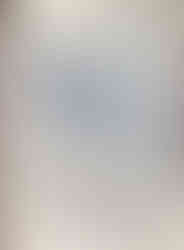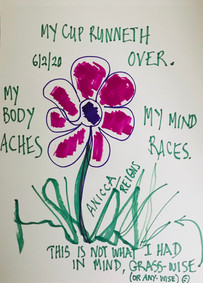Coronavirus Diary
- Zangmo Alexander

- Jun 11, 2020
- 5 min read
Updated: Jul 1, 2020
Meditate. Then do something visual and written about storylines/feelings in response to this coronavirus for 5 minutes maximum, each day. No rules except the time limit of 5 minutes making something each day. And no masterpieces allowed, no intellectualisations, just feelings from the gut, be authentic. It's great to do this with someone else, wherever they live: just share your day's diary entries with each other, maybe posting as a blog.
This Coronavirus Diary is a collaboration with artist, writer and Dharma friend Geraldine deLuca, who lives in Vermont, USA. We met while in a small group together on a Dharma and Art course at Barre Center for Buddhist Studies, USA. A friendship via Zoom ensued. With both of us wondering how to process the coronavirus pandemic, I mooted the idea of our doing parallel visual and written coronavirus diaries, emailing entries to each other daily. The aim would be to express and document the evolving process of learning to integrate Dharma and art practices with our experience of the pandemic, and maybe bring some understanding, clarity and even healing for ourselves and others.
Diary entries 5th May 2020-19th May 2020:
Both our diary entries are in galleries below, followed by reflections on the process.
Then there are more galleries with diary entries.
What has been happening
We emailed our diary entries on a daily basis, which I then uploaded. We do not comment on each other's work, as we do not want to engage with aesthetic or other evaluations and judgements.
After 10 days, Zangmo's reflections are:
This framework is extremely helpful for simplifying art and dharma
It is unpretentious, simple and frees the mind from 'trying to do good art'. As a result it is much easier to be direst and spontaneous
Sharing with a collaborator gives meaning and purpose
Not commenting on each other's work avoids competitiveness and ego-grasping while inviting acceptance and compassion
A process is emerging: in my own work I began by picturing storylines, the stuff of pain, dukka or suffering, and this will continue. Interwoven with this is emergence of spaciousness and letting go. While these themes run through all my work in general, using this framework allows for a narrative, time-based process to emerge which is different from video or book making.
Working fast gives expression from nowhere, nothingness, or the unconscious. As there is not enough time for concepts to kick in, the images/text emerge from a different level.
I am able to give voice to confusing, painful feelings, which helps bring understanding and acceptance to experience
A series of images expressing process and embracing change over time helps me accept and let be
Geraldine deLuca's Reflections
Reactions to doing the coronavirus diary with Zangmo, 5/20/20
Every day I get up and know that there is a small activity that I will do. I love doing it and it’s not onerous, time-consuming, and I get to share with Zangmo!
I usually meditate for a few minutes before doing the writing/drawing or painting. That sometimes suggests words or images. I’m not sure if that’ s good or bad because I can sometimes come to the page with a plan and maybe I don’t want that. I’m not sure.
More and more of my life during this time has become attuned to the way Buddhists see the world. I listen to talks every day while walking or falling (or not falling) asleep. This vision is infinitely soothing to me. I feel grateful to open my heart to it. And that enters my diary, especially since I’m sharing with Zangmo, who is a Buddhist.
Often I find myself judging what I do. Judgment is deep in my bones, and I’m trying to let it go. But it’s hard. The practice is valuable in making me aware of the judgments. It can lead me to ask questions: what if someone else drew that? Would I like/dislike it? Respect it? (AAAGH! You see how difficult this is.) But this is “what’s up” with me now, so I try to have compassion, affection for myself. Just keep letting go. Change is slow but ongoing.
This practice also makes me feel so privileged. To do this with Zangmo, whom I admire so much, to be invited into her world, her website, her way of moving forward in her vision. My life feels so rich. I have paper, pens, paint, a space to work. How fortunate I am. Most people in the world couldn’t even begin to imagine the luxury of this.
I am rooting around for materials that work in a short space. Mostly I’m using Prismacolor markers, which have their advantages and disadvantages. Paint feels more substantial, dramatic. But is that the point? I’m thinking about painting backgrounds on my “pages” or gesso boards beforehand, and then working with the color as a base—just to deal with the white space, which can feel daunting.
The writing Is easier. I notice the up and down-ness of each day. Maybe I’m tired. Couldn’t sleep. Headache. Or: I slept last night. What a gift. The physical body enters the diary. Every event: something happy, something sad, affects the diary. Of course. But it’s wonderful to have a small, regulated space in which to express the mood, the thoughts, the fears.
I tend to keep fear at bay. Which is wise in the Buddhist world, but I don’t want to muffle it when it’s there. Oh, fear. Okay. I am feeling fear. Most everyone is. Some days it can be very big. How is everyone doing this morning? Life is fragile and precious. Zangmo hurts her hand. A friend cracks her pelvis. So many people die. I am grateful for this diary which grounds my day in such a simple way—which is also so complex—gives me a sense of connection to the world, reminds me of the blessings.
Diary entries from 20th May 2020
Beginnining to edit the above materials for developing into a book. A Powerpoint exploration of images Geri and I have selected from the 80 diary images. Initial stream-of consciousness texts accompanying it.
Beginning to edit Lockdown Diary for developing into book form
29th June 2020
Discussion 1 with Geri
Agenda
How can we progress editing images and content to create an engaging and meaningful book for an informed audience of Buddhists, artists, spiritual seekers, educators, therapists, and interested lay public, ready for printing by 31st July? Self publishing initially? Or not?
Editing Options (based on ‘Handbook of Arts-Based Research’ by Leary, and ‘Poetic Inquiry’ by Faulkner) As this is a creative and dharma dialogue between two women Dharma practitioners expressing and sharing experience of lockdown, how can we retain this dialogue process, including being informed by a dharma and lockdown context, as we edit to create a book? What other contexts do you feel are necessary?
Possible dialogue options:
Poetic inquiry
Using collage to combine 2 images, one Geri’s, one Zangmo’s. Responding in relationship
Creative writing with or without image reflecting on how doing this diary in lockdown has helped our dharma practice
Creative writing with or without image reflecting on how doing this diary during lockdown has helped us grow personally
Meta-reflection (may include 3 and 4 above): 1000 words creative writing/create a new image/text piece summarising whole experience emotionally, cognitively in personal Dharma context











































































































































































































What a lovely idea! This is not new, but I found it this morning:
Forest of Waters
A beautiful scene has opened in my mind’s eye
A crystalline reservoir of water
Is beside a young forest
It is not dark and scary
But light and airy and welcoming
I enter in, and my spirit is refreshed
I meet my loved one and we embrace
O what a joyful reunion!
We remember our lifetimes together
As we exchange our vows for the eternities yet to come.
Bob Oberg